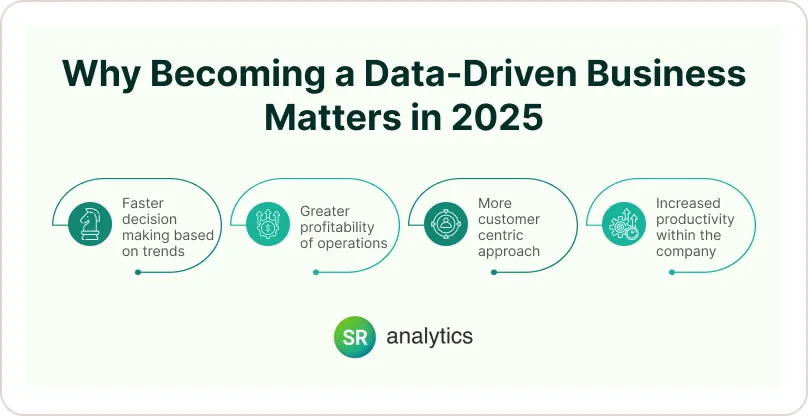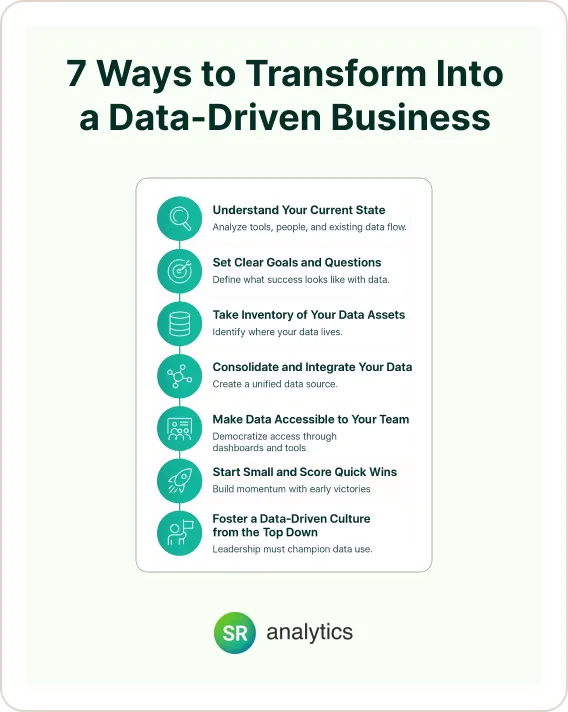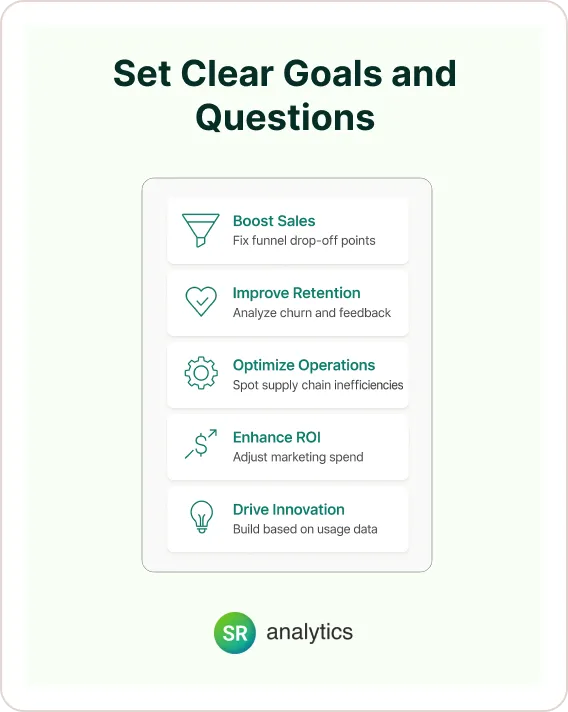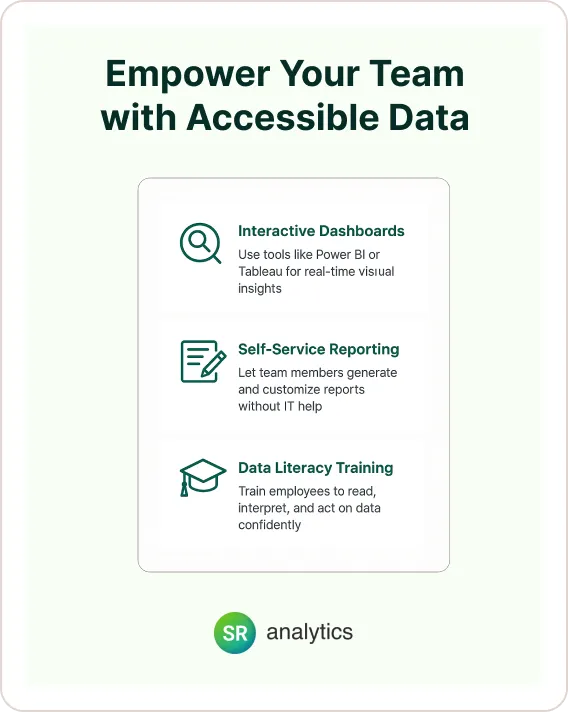Why Becoming a Data-Driven Business Matters in 2025

In today’s data-saturated world, relying on gut feeling or past experience is no longer enough. Companies of all sizes are generating and capturing more data than ever before – from customer behaviors and sales trends to operational performance.
The challenge is turning that flood of information into smart, evidence-based decisions that drive business success. Organizations that manage to do this reap huge rewards: data-driven companies are 23× more likely to acquire customers and 19× more likely to be profitable than those that don’t leverage their data.
Yet many businesses still struggle to become truly data-driven; for instance, only about 25% of organizations make nearly all strategic decisions based on data (and 44% make most decisions data-driven).
In this guide, we’ll walk through 7 proven ways to transform into a data-driven business. Each way includes practical explanations and examples to illustrate how you can put data at the heart of your decision-making.
By following these ways – from establishing the right goals and culture to enabling your team with the proper tools – you’ll be well on your way to creating a high-impact Data-Driven Business. And the payoff is worth it: companies that harness big data have reported an average 8% increase in revenue and a 10% reduction in costs. These outcomes are clear indicators of the value of a strong data driven business strategy. Let’s dive in.
7 Ways to Transform Into a Data-Driven Business

Step 1: Understand Your Current State
Before you chart a course to a data-driven future, take an honest look at where you stand today. These days, many companies claim to be data-driven business, but the reality often falls short. Do any of these sound familiar?
- Is your data easily accessible to everyone who needs it, or is it trapped in silos and systems only a few can reach?
- Do you have the tools, skills, and processes in place to analyze data effectively?
- How are decisions currently made in your organization – are they guided by data or by gut instinct?
If you hesitated or answered negatively to any of the above, there’s room for improvement. The first way to become a data-driven business is acknowledging the truth of your current situation. You’ll never reach true data maturity if you falsely believe you’re already there.
For example, you might discover that each department maintains separate databases that don’t talk to each other, or that managers still rely on personal intuition because they lack timely reports.
That’s okay – the key is to identify these gaps now. Conduct a thorough assessment: audit where your data lives, who can access it, and how decisions are made in practice. This baseline will highlight what needs to change and help you start refining your data driven business processes to support smarter, more unified decision-making.
Step 2: Set Clear Goals and Questions

Being a data-driven business is not the end goal; it’s the method. First, clarify what you’re trying to solve or improve. Align your data driven business strategy to business outcomes. Ask yourself:
- What specific business questions are we trying to answer?
- Which metrics will indicate success?
Common data-driven business decisions might include:
- Boosting sales: Fix funnel drop-off points.
- Improving retention: Analyze churn and customer feedback.
- Optimizing operations: Identify inefficiencies in the supply chain.
- Enhancing ROI: Track and adjust marketing spend based on performance.
- Driving innovation: Use product usage and testing data to build what customers want.
These goals shape what data to collect and how to use it. Remember: data without direction is just noise.
Step 3: Take Inventory of Your Data Assets
Now that you know your goals, examine what data you currently have (and what might be missing). Most companies are surprised to discover data sources they’ve been overlooking. You probably have more data available than you realize. Start by cataloging all the data sources across your organization:
- Customer data: e.g. CRM databases, sales records, website analytics, customer feedback surveys.
- Operational data: e.g. supply chain logs, inventory systems, manufacturing or delivery records, project management tools.
- Financial data: e.g. revenue and expense reports, budgets, pricing data.
- Employee data: e.g. HR systems, productivity metrics, internal surveys.
- External data: e.g. market research, industry benchmarks, social media trends, economic data, or third-party datasets.
Don’t forget “hidden” data that isn’t in traditional databases. For example, system log files (event data) from IT systems can be incredibly insightful. One company realized that their application event logs held the key to improving their processes: by mining this underutilized data, they visualized how orders moved through their system and identified bottlenecks causing delays.
The lesson? Valuable insights may be hiding in plain sight, in emails, support tickets, call center transcripts, IoT sensor readings – the list goes on. Engage different departments to understand what data they generate and use. You may find that marketing has a trove of web analytics, or that customer service has a detailed log of support issues that could inform product improvements.
After taking stock, ask: Do we have the data needed to answer our key business questions? If not, you might need to start collecting new data. But often, the initial focus for a data-driven business should be on better using the data you already have. Many organizations have siloed or ignored data that, if brought to light, could help make much smarter decisions —especially by improving their data driven business processes.
Step 4: Consolidate and Integrate Your Data
Inventory done? The next challenge is that your data might be scattered in disparate systems. It’s hard to be data-driven if your sales team’s data is on one platform, finance on another, and they don’t communicate. That’s why a crucial way is to break down data silos and create a unified view of your business information. In practice, this means consolidating your data into a centralized repository or ensuring different systems can talk to each other.
Some strategies to consider:
- Create a “single source of truth”: This could be a data warehouse, cloud database, or unified dashboard that pulls key data from all departments. Having one reliable repository ensures everyone is working with the same numbers.
- Integrate your systems: Invest in integration tools or middleware that connect your CRM, ERP, marketing software, etc. so data flows between them. For example, link your website analytics with your sales CRM to see how web leads convert to customers in one view.
- Standardize and clean data: Different departments might label or format data differently (one system says “UK”, another says “United Kingdom”). Establish common data definitions and clean up inconsistencies. This improves data quality and makes merging data possible.
- Eliminate duplicate efforts: If two teams are collecting the same data separately, consolidate that process. It saves time and reduces confusion when everyone references the same metrics.
Consolidation can be a technical endeavor, but it’s foundational. Imagine trying to make a company-wide decision on customer strategy when marketing, sales, and support each present different figures for customer count or lifetime value. Unifying these data sources gives you the complete picture.
For example, a retail business integrated its in-store point-of-sale data with its online ecommerce data – once combined, they uncovered patterns that neither dataset showed on its own. With consolidated data, you’re setting the stage for analysis that is comprehensive and trustworthy data driven business strategy, leading to far smarter decisions.
Step 5: Make Data Accessible to Your Team
Data is only powerful if the right people can use it at the right time. In many businesses, a big obstacle to data-driven decision-making is limited access: only a few analysts or the IT department can pull reports, while everyone else waits in line for information.
To truly become data-driven, empower your employees with self-service access to data and insights. That means equipping team members – not just executives or analysts – with user-friendly tools to explore data and find answers on their own. Examples include:

- Interactive dashboards and BI tools: Implement platforms like Tableau, Power BI, or other business intelligence dashboards that let users filter and visualize data on demand. A sales manager, for instance, can check real-time dashboard figures for their region without needing a custom report from IT.
- Self-service reporting: Provide web-based reporting systems or databases where employees can run standard queries (pre-built or drag-and-drop reports) to get the data they need. For example, a marketing specialist might use a self-service tool to segment customer data by demographics to inform a campaign.
- Training and data literacy: Tools are great, but people need to know how to use them. Invest in basic training so that staff at all levels are comfortable interpreting charts and using data in their day-to-day work. Encourage a culture where asking questions of the data is normal.
Importantly, IT still plays a role in setting up governance – ensuring data is secure and maintaining data integrity – but they shift from gatekeepers to enablers. With role-based permissions, employees can have appropriate access to data relevant to their jobs, without bottlenecks.
When more team members have timely access to facts, better decisions follow naturally. For example, imagine a customer support team that can instantly pull up data on past interactions to personalize their service, instead of escalating requests for an analyst to do it later. Or a supply chain manager who gets an automatic alert from a live dashboard when inventory runs below a threshold, allowing faster restocking decisions.
In a data-driven business, information flows freely to those who need it. In fact, democratizing data access is no longer optional – it’s a necessity for any organization that wants to compete on analytics in today’s data-rich environment. The more people who can glean insights, the smarter and faster your collective decisions will be.
Step 6: Start Small and Score Quick Wins
Transforming into a data-driven organization can feel overwhelming. You might wonder, where do we even begin? The answer: start small, then scale up. You don’t have to (and probably can’t) do everything at once.
In fact, trying to overhaul every process overnight with data analytics can backfire – it may overextend resources and intimidate employees who are new to data practices. A smarter approach is to pick one high-impact area or project as a pilot, and focus your initial efforts there.
For example, you could choose to apply data-driven decision-making to improve your inventory management this quarter, or to reduce customer churn in one region, or to optimize a single production line in the factory. By narrowing scope, you make the task manageable and can deliver results faster.
Quick, tangible wins are critical: they build momentum, prove the value of data to skeptics, and provide learning experiences for your team. If your first project shows a boost in efficiency or revenue thanks to data insights, it will be much easier to get buy-in for the next project.
Step 7: Foster a Data-Driven Culture from the Top Down
Last but certainly not least, remember that becoming a data-driven business is as much about people and culture as it is about data and tools. You can have the best analytics platform and pristine data, but if your company’s mindset doesn’t change, you won’t see the transformation you’re hoping for.
It starts at the top. Leadership must not only endorse the idea of data-driven business decisions – they need to actively practice and promote it as part of your broader data driven business processes.
Why the focus on leadership? Because if executives and managers continue to make decisions based purely on opinion, instinct, or the old way of doing things, it sends a signal to everyone else that data isn’t truly valued.
In contrast, when leaders consistently ask for data in meetings, back up their directives with evidence, and celebrate team members who use insights to drive results, it creates a powerful ripple effect. Employees take notice and begin to mirror those behaviors.
Becoming a data-driven company is a culture shift, and culture change requires buy-in from the top levels.
Here are a few ways leadership and management can champion a data-driven culture:
- Lead by example: Make a point to use data in your own decisions. For instance, a department head might share key metrics on team performance in each weekly update, showing transparency and trust in the numbers.
- Set data-backed targets: Ensure that goals and OKRs (Objectives and Key Results) at every level include metrics. If every team has clear, measurable targets, it normalizes the idea that success is defined by data.
- Encourage curiosity and questioning: Create an environment where team members can question decisions or strategies by asking “What does the data say?” without fear. Encourage teams to test assumptions with experiments and data analysis.
- Invest in skills and celebrate wins: Provide resources for training in data literacy. When data projects succeed – no matter how small – recognize those teams publicly. This reinforces the positive behavior and shows that data-driven success is a big deal.
Also, consider appointing data champions or a dedicated data team if your company size warrants it. A Chief Data Officer or an analytics leader can help keep the organization focused on best practices and continuous improvement, and driving effective data-driven business processes. But even without a formal role, every leader should consider themselves a champion for data usage.
Above all, consistency is key. Cultural shifts don’t happen overnight. Keep reinforcing the message that “In this company, decisions are guided by data.” When new hires come in, instill that philosophy from day one.
Over time, as people see that acting on insights (rather than hunches) leads to better outcomes, they’ll embrace the change. The end result is a business where asking for evidence, measuring results, and iterating based on what the data shows becomes second nature – truly a data-driven culture.
Conclusion
Becoming a data-driven business is a journey, but it’s one of the most rewarding journeys you can undertake in today’s competitive landscape.
By following these seven ways – understanding your starting point, setting clear goals, leveraging your data assets, consolidating information, empowering your team with access, starting small, and nurturing a data-centric culture – you create a roadmap for smarter, faster, and more confident data-driven business decisions at all levels of your organization.
Remember, it’s not just about investing in new technology or hiring data scientists; it’s about changing how your company thinks and operates on a daily basis.
The good news is that every way forward builds momentum. Each quick win, each insightful report, each data-informed strategy will strengthen the case for going further. And the impact on your business can be transformational.
We’ve seen that companies who fully embrace data can dramatically outperform those who don’t. They innovate faster, delight their customers, and operate more efficiently – often translating into tangible financial gains.
In fact, leveraging data analytics has been shown to increase revenues by ~8% and cut costs by 10% on average. Those are improvements no business can afford to ignore.














